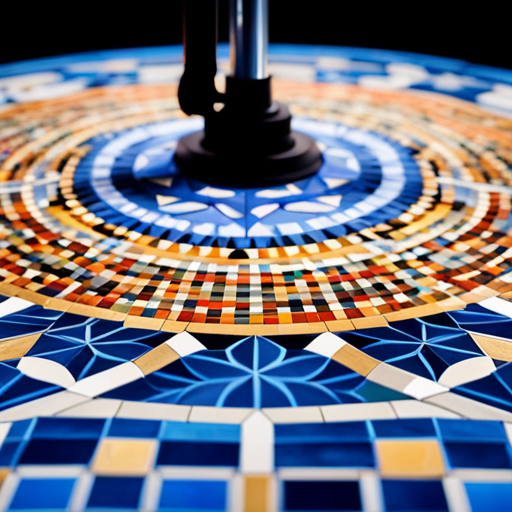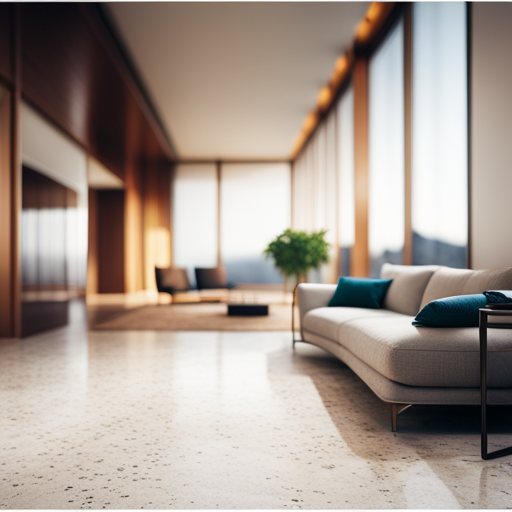The Art of Hand-Painted Floor Tiles

Have you ever wondered about the intricate artistry behind hand-painted floor tiles?
Delve into the rich history, cultural influences, and contemporary design trends of this time-honored craft.
From the origins of hand-painted tiles to their unique applications in interior design, this article explores the techniques, traditions, and maintenance tips that make these tiles a captivating and enduring feature of architectural and artistic expression.
Origins of Hand-Painted Tiles
The origins of hand-painted tiles can be traced back to ancient civilizations, where skilled artisans adorned floors with intricate and meaningful designs. This traditional craftsmanship was not merely a decorative element, but held deep cultural significance. In many cultures, these hand-painted tiles served as a form of storytelling, depicting historical events, religious symbolism, or daily life scenes.
The meticulous process of creating these tiles involved a mastery of techniques passed down through generations, showcasing the importance of preserving heritage and skills.
The art of hand-painted tiles was a reflection of the values and beliefs of the society in which they were created. Each brushstroke carried with it the essence of the culture, making these tiles not only aesthetically pleasing but also a valuable historical record. As civilizations evolved, this art form adapted and incorporated diverse influences, yet the essence of traditional craftsmanship and cultural significance remained at its core.
Understanding the origins of hand-painted tiles provides insight into the techniques and artistry that have shaped this timeless craft.
Techniques and Artistry
The techniques and artistry involved in hand-painted floor tiles are a testament to the skill and precision of the artisans who create them. From brush stroke techniques to color blending methods, every aspect of the artistic process plays a crucial role in the final product.
Furthermore, the artistic inspiration and influences behind each design provide a deeper understanding of the cultural and historical significance of hand-painted floor tiles.
Brush Stroke Techniques
How can brush stroke techniques elevate the artistry of hand-painted floor tiles?
Brush stroke styles play a pivotal role in expressing artistic flair. Traditional techniques, rooted in culture, bring depth and heritage to the designs, while modern approaches infuse innovation and contemporary relevance.
The choice of brush stroke style directly impacts the overall aesthetic and emotional impact of the tile art. The way an artist wields the brush can convey movement, texture, and mood, adding layers of meaning to the visual narrative.
Moreover, the interplay between traditional and modern techniques reflects the cultural significance of hand-painted floor tiles, bridging the past and present in a visually captivating manner.
Ultimately, mastering brush stroke techniques is essential for achieving the desired artistic expression and connecting with the audience.
Color Blending Methods
Brushing and blending colors with precision and artistry are essential techniques in creating captivating hand-painted floor tiles.
Color mixing is a fundamental aspect of the process, requiring a deep understanding of color theory. Artists skillfully use brush techniques to blend colors seamlessly, creating smooth transitions and captivating visual effects.
Whether employing wet-on-wet blending or dry brush techniques, the mastery of these methods is crucial to achieving the desired aesthetic.
Furthermore, artistic expression plays a significant role in color blending, as it allows the artist to infuse their unique style and creativity into the tiles.
Through the harmonious blending of hues and tones, hand-painted floor tiles become exquisite works of art, adding beauty and personality to interior spaces.
Artistic Inspiration and Influences
Employing a range of artistic techniques and drawing inspiration from various influences, skilled artisans elevate the creation of hand-painted floor tiles to a form of expressive artistry.
Artistic interpretation plays a pivotal role in the creative process, allowing artisans to infuse their work with personal meaning and emotion. Influences from diverse cultural traditions and historical art movements further enrich the artistic process, contributing to the uniqueness of each hand-painted floor tile.
Techniques such as trompe l’oeil, where realistic imagery creates an optical illusion of three-dimensionality, add depth and complexity to the tiles. Artisans also utilize intricate patterning and storytelling elements, drawing from folklore, mythology, and nature to imbue the tiles with narrative and symbolism.
This fusion of techniques and influences results in hand-painted floor tiles that are not just functional, but also captivating works of art.
Cultural Influence and Traditions
Exploring the cultural influence and traditions behind hand-painted floor tiles unveils a rich tapestry of historical symbolism, regional color palettes, and artisan techniques and tools.
These elements not only reflect the artistic prowess of a particular community but also serve as a window into the cultural heritage and traditions that have shaped the art form.
Historical Symbolism in Tiles
Throughout history, floor tiles have served as a canvas for cultural symbolism and traditions. The historical significance of hand-painted floor tiles lies in their ability to depict and preserve cultural representation through intricate designs and motifs.
These tiles have been used to convey the stories, beliefs, and values of diverse societies, reflecting their unique heritage and identity. The following are three key aspects of historical symbolism in tiles:
-
Religious Imagery: Tiles often feature religious symbols and scenes, such as depictions of saints, religious events, or sacred geometry, showcasing the spiritual beliefs of a community.
-
Folklore and Mythology: Many tiles incorporate imagery derived from local folklore and mythology, portraying legendary tales and mythical creatures that are significant to the culture.
-
Political and Social Commentary: Some tiles bear political and social commentary, offering insights into the historical context and societal issues prevalent at the time of their creation.
Regional Color Palettes
The historical symbolism in tiles, with its emphasis on religious imagery, folklore, and social commentary, is intricately intertwined with the regional color palettes that reflect cultural influence and traditions. Color psychology plays a significant role in determining regional significance, as different colors hold diverse meanings across various cultures. Traditional patterns, such as the use of specific motifs and geometric designs, are often incorporated into the regional color palettes, representing the heritage and history of the area.
However, these traditional elements are also subject to modern interpretations, where contemporary influences and global trends are integrated into the color schemes. Understanding the regional color palettes and their cultural significance provides insight into the intricate storytelling woven into hand-painted floor tiles, which is further enhanced by the artisan techniques and tools used in their creation.
Artisan Techniques and Tools
Artisan techniques and tools, deeply rooted in cultural influence and traditions, are often meticulously passed down through generations, reflecting the enduring legacy of craftsmanship in hand-painted floor tile production. The art of hand-painted floor tiles relies on artisan craftsmanship and the utilization of traditional tools, which have been refined over centuries. The cultural influence on these techniques is evident in the intricate patterns, motifs, and designs that are characteristic of specific regions.
The following elements are essential in understanding the significance of artisan techniques and tools in hand-painted floor tile production:
-
Cultural Heritage: Techniques and tools are deeply intertwined with the cultural heritage of a particular region.
-
Generational Knowledge Transfer: The skills and knowledge are transmitted from one generation to the next, ensuring the preservation of traditional methods.
-
Influence on Design Aesthetics: The tools and techniques employed significantly impact the aesthetic appeal and uniqueness of hand-painted floor tiles.
Contemporary Design Trends
Many contemporary interior designers are incorporating hand-painted floor tiles to add a touch of artistic flair to their projects. This trend has led to an emergence of contemporary patterns and modern color schemes in the realm of hand-painted floor tiles. Designers are exploring geometric shapes, minimalist designs, and bold color combinations to create a modern and sophisticated look in interior spaces. The use of hand-painted floor tiles allows for a unique and customized approach to flooring design, offering a level of individuality that is hard to achieve with mass-produced tiles.
| Contemporary Patterns | Modern Color Schemes |
|---|---|
| Geometric shapes | Bold and vibrant |
| Minimalist designs | Monochromatic |
| Abstract motifs | Neutral with pops of color |
| Asymmetrical layouts | Pastel tones |
| Organic patterns | Contrasting shades |
These contemporary design trends are reshaping the way hand-painted floor tiles are perceived, moving them beyond traditional and ornate styles into the realm of modern, sleek, and visually stimulating designs. The versatility of hand-painted floor tiles allows for endless possibilities in creating unique and eye-catching interiors.
Installation and Maintenance Tips
Emerging contemporary design trends have increased the demand for hand-painted floor tiles, prompting a need for comprehensive installation and maintenance tips to ensure the longevity and visual appeal of these artistic flooring solutions.
Proper sealing and cleaning are essential for preserving the beauty and integrity of hand-painted floor tiles.
Here are some crucial tips for installation and maintenance:
-
Proper Sealing: Ensure that the hand-painted floor tiles are adequately sealed to protect them from moisture, stains, and wear. Use a high-quality sealant to provide a protective layer without compromising the aesthetic appeal of the tiles.
-
Regular Cleaning: Implement a regular cleaning routine using a mild, pH-neutral cleanser to maintain the tiles’ vibrant colors and intricate designs. Avoid harsh chemicals or abrasive cleaning tools that can damage the painted surface.
-
Longevity and Durability: To maximize the lifespan of hand-painted floor tiles, it’s important to invest in high-quality materials and professional installation. Additionally, regular maintenance and timely repairs can help prevent minor issues from escalating and ensure the long-term durability of the tiles.
Unique Applications in Interior Design
Hand-painted floor tiles offer a unique and versatile design element for interior spaces, allowing homeowners to infuse their living areas with artistic flair and individuality.
Custom patterns, whether inspired by traditional motifs or contemporary designs, provide a means for creative expression within the home. These hand-crafted tiles can be used to create intricate mosaics or striking feature areas in various rooms, adding a touch of timeless elegance to the interior.
Additionally, the modern applications of hand-painted floor tiles extend beyond traditional use in kitchens and bathrooms to include unexpected spaces such as living rooms, hallways, and even outdoor patios. The ability to customize the design and color palette of these tiles enables homeowners to tailor the look and feel of their living environment according to their personal style and preferences.
Whether aiming for a classic, sophisticated ambiance or a bold, modern statement, hand-painted floor tiles offer a distinctive way to elevate interior design.
Frequently Asked Questions
Can Hand-Painted Floor Tiles Be Customized to Fit Specific Design Preferences or Color Schemes?
Yes, hand-painted floor tiles can be customized to fit specific design preferences and color schemes. This allows for personalized patterns and custom designs to be incorporated, providing a unique and tailored aesthetic for any space.
Are There Any Special Considerations or Precautions to Take When Installing Hand-Painted Floor Tiles in High-Traffic Areas?
When considering the installation of hand-painted floor tiles in high-traffic areas, it’s crucial to prioritize durability and maintenance. Choose a reliable installation method, opt for sealants, and implement regular cleaning and maintenance tips to preserve the intricate design customization.
How Do Hand-Painted Floor Tiles Compare in Terms of Durability and Longevity to Other Types of Flooring Materials?
When considering flooring options, hand-painted floor tiles offer a unique blend of durability and customization. Their longevity is comparable to other materials, but installation considerations and specialized cleaning methods are essential for maintaining their beauty.
Are There Any Recommended Cleaning Products or Methods for Maintaining the Vibrancy and Beauty of Hand-Painted Floor Tiles?
To maintain the vibrancy and beauty of hand-painted floor tiles, it is essential to use recommended cleaning products and gentle maintenance methods. Long-term care involves preserving the intricate designs and colors of hand-painted floor tiles.
Can Hand-Painted Floor Tiles Be Used in Outdoor or Wet Areas, Such as Bathrooms or Kitchens?
In outdoor applications, hand-painted floor tiles can enhance the aesthetic appeal of spaces like bathrooms and kitchens. To maintain their vibrancy, regular cleaning with a mild soap and water, avoiding harsh chemicals, will preserve their beauty.
Conclusion
In conclusion, the art of hand-painted floor tiles has a rich history, intricate techniques, and cultural significance that continue to influence contemporary design trends.
From its origins to unique applications in interior design, hand-painted tiles showcase the artistry and craftsmanship of various cultures.
As we walk on these beautifully crafted tiles, we are reminded of the enduring traditions and creativity that have been passed down through generations, creating a timeless and meaningful connection to our surroundings.

Rubin Everest, a seasoned expert in the world of flooring, brings a wealth of knowledge and passion to the surface. As the mind behind ebbow.com, Rubin is dedicated to sharing insights on the latest trends, innovative solutions, and expert advice in the realm of flooring. Whether you’re seeking practical tips for installation or design inspiration, Rubin Everest is your go-to source for all things flooring-related, making your journey to the perfect floor an informed and enjoyable experience.





